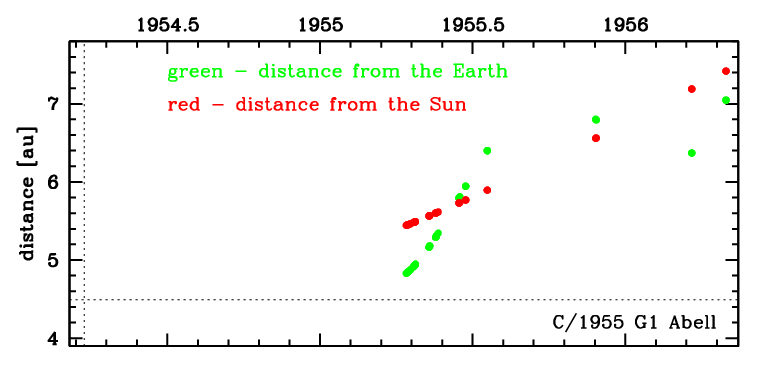C/1955 G1 Abell
more info
Comet C/1955 G1 was discovered on 13 April 1955, a year and three weeks after perihelion passage, and was last seen on 30 April 1956 [Kronk, Cometography: Volume 4].
The comet made two close approaches to the Earth: on 24 July 1953 (4.09 au, eight months before perihelion passage), and on 21 May 1954 (4.03 au, two months after perihelion).
Solution given here is based on data spanning over 1.1 yr in a range of heliocentric distances from 5.45 au to 7.42 au.
This Oort spike comet suffers small planetary perturbations during its passage through the planetary system that lead to escape the comet from the planetary zone on a hyperbolic orbit (see future barycentric orbit).
See also Królikowska and Dybczyński 2017.
The comet made two close approaches to the Earth: on 24 July 1953 (4.09 au, eight months before perihelion passage), and on 21 May 1954 (4.03 au, two months after perihelion).
Solution given here is based on data spanning over 1.1 yr in a range of heliocentric distances from 5.45 au to 7.42 au.
This Oort spike comet suffers small planetary perturbations during its passage through the planetary system that lead to escape the comet from the planetary zone on a hyperbolic orbit (see future barycentric orbit).
See also Królikowska and Dybczyński 2017.
| solution description | ||
|---|---|---|
| number of observations | 35 | |
| data interval | 1955 04 13 – 1956 04 30 | |
| data type | observed only after perihelion (POST) | |
| data arc selection | entire data set (STD) | |
| range of heliocentric distances | 5.45 au – 7.42au | |
| detectability of NG effects in the comet's motion | NG effects not determinable | |
| type of model of motion | GR - gravitational orbit | |
| data weighting | NO | |
| number of residuals | 63 | |
| RMS [arcseconds] | 1.00 | |
| orbit quality class | 1b | |
| orbital elements (heliocentric ecliptic J2000) | ||
|---|---|---|
| Epoch | 1954 04 08 | |
| perihelion date | 1954 03 24.11491792 | ± 0.01172030 |
| perihelion distance [au] | 4.49562524 | ± 0.00010953 |
| eccentricity | 1.00279180 | ± 0.00007595 |
| argument of perihelion [°] | 73.749143 | ± 0.001855 |
| ascending node [°] | 321.334541 | ± 0.000335 |
| inclination [°] | 123.932726 | ± 0.00028 |
| reciprocal semi-major axis [10-6 au-1] | -621.00 | ± 16.90 |
